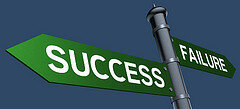Case Study: 2 Key Leverage Points for Change
I'd like to share a success story. It's a case study of a leader and team that soared, how they did it and the specific results they achieved.I had the privilege of coaching and consulting to a health care department (made up of four teams) for two years. Personally, I had very high satisfaction because I was able to work with the team step-by-step and witness their evolution and the gains they sustained over an extended period of time. The situation: As luck would have it, the department chief, Dr. Chan and the department manager, Janice were both newly appointed and highly motivated. Dr. Chan was open to learn, willing, and dedicated. He was not a charismatic leader but he was respected for his technical skills. He was known as responsible and reliable and therefore had earned some trust going into his new role. By dedicating resources to the team's development and education, he demonstrated his commitment to the team.The department's physical work environment was antiquated and cramped. Although they had been promised a new clinic for several years, there was no new construction on the horizon.Metrics: The department was measured quarterly in five key areas against 18 other like-departments within the organization.
The situation: As luck would have it, the department chief, Dr. Chan and the department manager, Janice were both newly appointed and highly motivated. Dr. Chan was open to learn, willing, and dedicated. He was not a charismatic leader but he was respected for his technical skills. He was known as responsible and reliable and therefore had earned some trust going into his new role. By dedicating resources to the team's development and education, he demonstrated his commitment to the team.The department's physical work environment was antiquated and cramped. Although they had been promised a new clinic for several years, there was no new construction on the horizon.Metrics: The department was measured quarterly in five key areas against 18 other like-departments within the organization.
- Employee Satisfaction
- Service / Customer satisfaction
- Quality
- Access to care
- Budget
They occupied the bottom 1-3 positions Service / Customer Service metric for a few years running. Additionally, they broke records for workers comp claims and sick days. There was team divisiveness. And as you might imagine low employee satisfaction.Recruiting for new hires was tough because of its reputation as a dysfunctional place to work and the cramped and inadequate working conditions. There was high turnover, they were continually short-staffed, all of this adding to their stress and job dissatisfaction.So let me get to the punch line now. As a result of effective leadership, this department pulled together, soared to the number one position and stayed there for several consecutive quarters. Last I checked, they were still the top performers after two years.
- They became Service Stars
- Employee satisfaction improved significantly
- Quality Maintained
- Access Targets Met and Maintained
 And there was a positive "ripple effect" on areas that weren't targeted for improvement:
And there was a positive "ripple effect" on areas that weren't targeted for improvement:
- Efficiency Increased
- Lowered cost of care
- New workers’ Comp claims reduced
- Absenteeism reduced significantly
If you want to know how we did it, read on ...What were the conditions for success?
- Dept. leadership agreed that change was needed
- Dept. leadership agreed to commit to team development for the duration
- Dept. leadership secured sponsorship of Medical Center administration
- Dept. leadership and medical center administration alignment
- Secured OD consultant and coach resource for ongoing leader and team development
What did we do?I did a department-wide assessment, wrote up my findings and proposed a plan of action. Together with the department chief and manager we formed a plan to engage and involve the entire department in developing a vision, goals and strategy. Dr. Chan and Janice agreed to commit to three department offsite meetings per year, monthly team meetings and weekly department leadership meetings. We added a two more members to the leadership team: the chief of service and physician communication, and the labor partner.Based upon the assessment, the focus for team development was to:
- build trust by:
- getting to know themselves and each other better
- using diversity as strengths
- learning to communication effectively
- learning to collaborate
- engaging in healthy and productive conflict
- learn how to make decisions together
- hold each other accountable
- learn how to run effective meetings
- have fun together
Together, they built a department culture to engender
- Open communication
- High involvement and engagement
- Collaborative problem solving
- Consensus building
- Labor / Management collaboration
- Celebration of success
- Reward and recognition
The leadership behaviors that contributed to the overall success of this department are not necessarily the ones you hear about. Dr. Chan was fairly quiet and unassuming, he was humble and he was open and willing to learn. Janice was a bit of a maverick, optimistic, creative and extroverted. They aligned and stayed in sync so that nobody could work one against the other. They both demonstrated caring and warmth. Despite his discomfort, Dr. Chan learned to confront the disruptors.By dedicating resources to team development and agreeing to implement decisions generated by the department, they both demonstrated a commitment to change.With skin in the game, they built trust with staff and administration. As administration witnessed the results of their focus on team development, they continued to resource it. This department was recognized for their successes within the medical center and across the region.
We didn't do anything fancy, there was no charismatic leader, and Steve Jobs was not needed for this assignment. They used leadership basics, and that goes a long, long way.KEY TAKEAWAYSEngage and involve your people, give them an opportunity to influence business operations and make a difference. Surface the wisdom of your team collectively and individually.Take care of your people and they'll care for each other and the customers.Be trustworthy.Build team trust--that is the foundation for everything else. That singular focus had a positive and lasting impact on all the metrics.
Your two greatest assets: The way you lead and your team. These are your key leverage points to shift the system and change everything.
___________________________________________________Does this sound familiar? Love to hear your comments!


